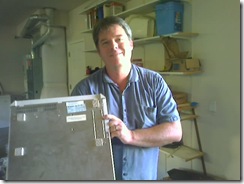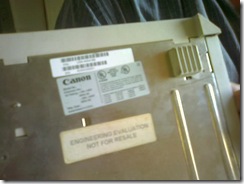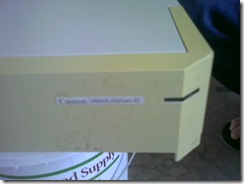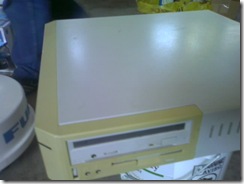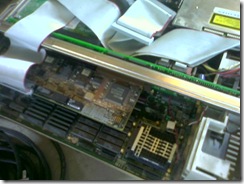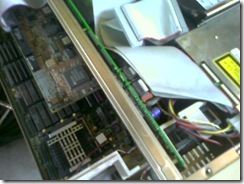About a week ago, I was tinkering with a few external SCSI drives. These external drives are those that draw power from one of the ports in a computer, instead of a wall wart or a direct power plug. In the process, I was humbled to learn a couple of lessons in electronics (I’m a software guy).
A couple of them are enclosures that draw power from an ADB port that is available on the Apple IIgs and older Macintoshes. The ADB port can be used as a source for +5v. These enclosures house 2.5” SCSI drives that were normally used in older Apple laptops before they switched to using IDE drives. These drives just need +5v and do not need the additional +12v source that the bigger 3.5” drives need.
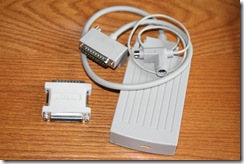
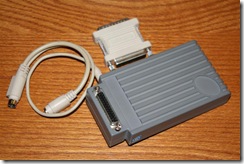
One of the 2.5” drives I used was a 1GB Microtech RoadRunner drive. It is a slim IDE drive bolted to a SCSI-IDE adapter resulting in the same form factor as a regular 2.5” drive. Kind of helpful to know, since those old 2.5” SCSI drives are getting harder to find.
My first humbling lesson is learning that using the wrong polarity will kill something. Both enclosures have a barrel attachment to the power line connecting to the ADB port. Connection looked the same, but the first one was center-positive. I tried using the same center-positive line in the other enclosure and poof! – the ADB port in my IIgs just… died. Keyboard and mouse stopped working, +5v source not coming out, and so on. I could have attempted to bring out my soldering stuff, but eventually (remember that I’m not a hardware guy), I ended up sourcing another IIgs motherboard from a fellow Apple enthusiast.
The next couple of SCSI enclosures I worked with were for 3.5” SCSI drives. As mentioned, 3.5” drives typically need +12v and +5v. These enclosures were meant to connect to the DB-19 drive connector at the back of the IIgs or a chained external diskette drive.
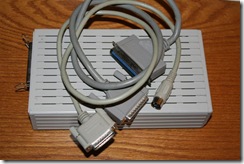
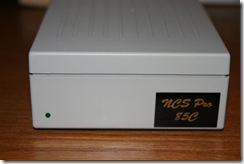
The former is a MicroNet Technology MP-20 with a 20MB SCSI drive. It has a power cable from a DB-19 plug to a 5-pin DIN connector. From tracing the lines and referencing the DB-19 pinouts, the 5-pin DIN connector has the following pinout:

- Pin 1: +5v
- Pin 2: Ground
- Pin 3: +12v
- Pin 4: NC
- Pin 5: NC
The latter was an NCS Pro 85C with an 80MB SCSI drive. These were both impressive and expensive back in the days. For some reason, I don’t have the power cable for this. The power cable was supposed to connect from the DB-19 port and into the 3-pin mini-DIN socket behind the enclosure.
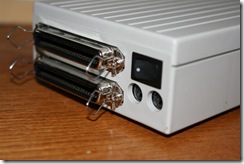
Not having been humbled enough with my polarity fiasco, I proceeded to wire up my own cable for the drive. I had an extra DuoDisk cable that I cut up to get the DB-19 end, but was stumped on the mini-DIN connector.
My first attempt involved noticing that LocalTalk cables (the ones that run the network length, not the ones that attach to the serial port) have those connectors. After performing once more the ritual dance of sacrificing a very good piece of hardware to make something else, I found out that the LocalTalk cable only had two lines. Well, duh! Networking only needs two lines. The gods weren’t looking favorably at me that day.
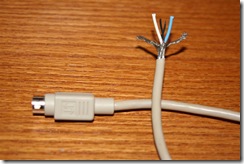
Off I went to the local Goodwill thrift store looking for a power adapter that uses the 3-pin mini-DIN connector. Sure enough, I found one (I think it was for a Westell DSL modem). The source voltage(s) did not matter since I would be cutting the cable. I had to shave some plastic off the connector before it would snugly fit into the socket at the SCSI enclosure box.
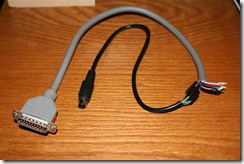
That’s when I had my second humbling lesson. I followed the traces wrong and initially had +5v going into the +12v line, and vice versa. This killed two of my SCSI drives (including the original one inside the NCS Pro 85C) before I realized what was wrong. After switching the two lines, I finally got one of my other IIgs to boot off the external drive.
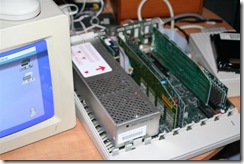
You can see in the pictures the two partitions I have in the new SCSI drive I placed inside the enclosure.

